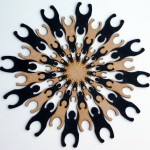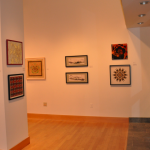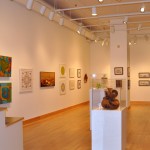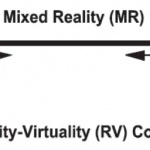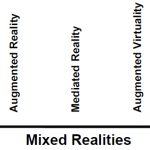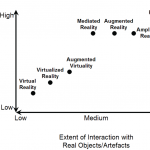Selected artwork pieces from the golden ratio module are going to be exhibited at the College of Fine Arts Gallery, Towson University. The “Man-shaped figures” will be kept for a month-long exhibition. More at “2012 Bridges Conference”.
Author: hj
Invited talk at HitLabNZ: Tangible and Augmented Reality Interaction for Smart Home Environments
by Jun Hu, Gerrit Niezen and Bram van der Vlist, on April 24, 2012
[youtube]http://www.youtube.com/watch?v=4-p-8Avx53g[/youtube]
Design Research on Social Computing
In the era of social networking and computing, the creation of intelligent systems, products, and related services in a social context is facing a number of technology supported social challenges.
Reality to Virtuality continuum
In their paper [PDF, 200K], “FROM VIRTUALITY TO REALITY AND BACK”, the authors presented an overview of the “reality” concepts in design and related areas, including Milgram and Colquhoun (1999)’s Reality to Virtuality continuum, as well as a classification of reality concepts according to correlation between perception and action and level of interaction.
Interview by the journal “Creation and Design”
During my sabbatical visit to Jiangnan University last year, I was interviewed by the journal “Creation and Design”. I was asked about my opinion about the topics such as interaction design, design education and training, as well as my impression about industrial design education in China etc. Well, if you read Chinese, here is the article:
FULLTEXT: PDF REFERENCE: BibTeX EndNote
DOI: 10.3969/J.ISSN.1674-4187.2012.01.002
Speakers’ Corner: “Out of Control” Presentations.
Thursday, March 1, at 3pm, without inviting any audience, I walked in the theme Out of Contol, started a presentation to no one, about semantic, social and physical networking. Caught some attention, finished by simply walking away. “Out of Control”, it is about Distributed being and control from bottom-up, right?
Continue reading Speakers’ Corner: “Out of Control” Presentations.
Semantic Web for Robots: An Application for Interoperability between virtual worlds and real robots

PhD project done by Alex Juarez.
The topic of this PhD project is in the context of cross-reality, a term that defines mixed reality environments that tunnel dense real-world data acquired through the use of sensor/actuator device networks into virtual worlds. It is part of the ongoing academia and industry efforts to achieve interoperability between virtual and real devices and services.
Scholarship from CSC: PhD in “Creating intelligent systems, products and related services in a social context”
About Scholarship from China Scholarship Council for Chinese PhD candidates: from TU/e; from CSC (in Chinese).
The department of Industrial Design (ID) of the Eindhoven University of Technology (TU/e) is located in a highly industrialized region, known as ‘Brainport’. This region is internationally recognized as a top technology area with a special focus on the integration of design and technology. The department was established in close collaboration with the technological industry, and, because of this, focuses its research on the Design of Intelligent Systems, Products and related Services in a social context. With these intelligent systems it aims at offering new, breakthrough possibilities leading to societal transformations.
EIT ICT Labs Master’s Programme in ICT Innovation
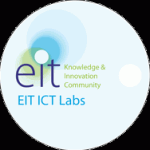
The EIT ICT Labs Master School offers two year programmes where you can choose two universities in two different European countries to build a curriculum of your choice based on your skills and interest. The school offers double degrees, which combines technical competence with a set of skills in Innovation and Entrepreneurship. While you get an excellent theoretical education, you also get the opportunity to work with European top research institutes and leading business partners.
Deadline for applications: February 15th
Visit EIT ICT Labs Master School on
Integrating Technology for Intelligent Products, Systems and Services
by Dr. Jun Hu and Prof. Loe Feijs @IDI, Zhejiang University, 2011 @IDI, Zhejiang University, 2011.
[youtube]http://www.youtube.com/watch?v=58vLhudS77k[/youtube]
(if you can not see the YouTube video, a link to the YouKu video is at the end of the article. “Read more …” to reveal it.)
Continue reading Integrating Technology for Intelligent Products, Systems and Services
